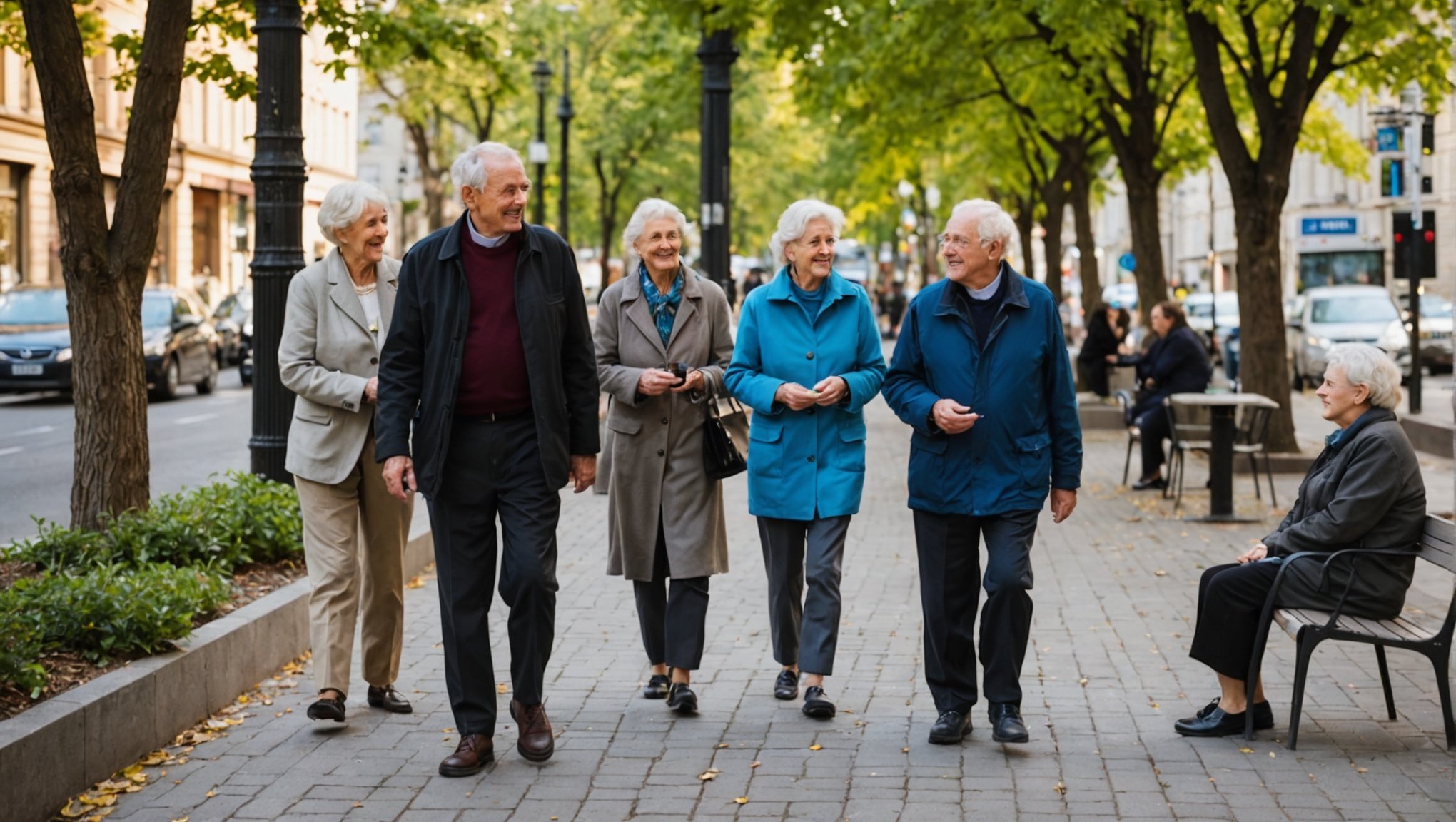Accessibility Features
Designing inclusive spaces is essential in today’s world, particularly concerning senior mobility. By employing thoughtful accessibility design, we can create environments that are not only functional but also welcoming to everyone.
A critical aspect of accessibility is the barrier-free design. This involves removing obstacles that may impede movement and ensuring that all individuals, including those with mobility challenges, can navigate spaces with ease. When creating inclusive spaces, it’s vital to consider the implementation of clear signage and wayfinding. Signage should be easy to read and strategically placed to guide individuals through the environment efficiently. This small change can have a significant impact, especially for seniors or those unfamiliar with a location.
In the same genre : Unlocking Profits: Discover the Financial Benefits of Investing in Energy-Efficient Commercial Properties
Incorporating physical elements such as ramps and elevators is also crucial. Best practices for these include ensuring ramps have gentle slopes and are equipped with handrails for additional safety. Elevators should provide clear instructions and controls that are reachable for individuals in wheelchairs. Additionally, having audible floor announcements can benefit those with visual impairments.
Together, these elements of inclusive design foster environments where all individuals, regardless of ability, can access and enjoy spaces without hindrance. Through thoughtful planning and execution, we can achieve truly accessible places for all.
Additional reading : Exploring the Legal Considerations for Transforming Industrial Spaces into Homes in Birmingham: What You Need to Know
Safety Considerations
Ensuring safety for seniors in urban areas requires thoughtful urban design. Effective strategies often begin with integrating good lighting into public spaces. Adequate lighting not only improves visibility but also reduces potential hazards in poorly lit areas, creating safer environments for the elderly.
Designing safe walking paths and crossings is another crucial aspect of senior safety. These pathways should be strategically located and clearly marked, with smooth surfaces to prevent tripping and sufficient width to accommodate mobility aids.
Urban design aimed at crime prevention can significantly enhance safety. The concept of Crime Prevention Through Environmental Design (CPTED) suggests that modifying the physical environment can deter criminal behavior. Key strategies include:
- Increasing natural surveillance through design that allows for unobstructed lines of sight.
- Employing territorial reinforcement with clearly defined spaces that encourage a sense of ownership among community members.
- Managing access control to areas by using fences, gates, or distinct entry points to reduce unauthorized entry.
By prioritizing these design elements, we can create urban spaces that are not only inclusive but also promote the well-being of seniors. Thoughtful urban planning not only enhances physical safety but also contributes to a greater sense of community connectedness and trust, ultimately leading to vibrant and livable public spaces for everyone.
Social Engagement Opportunities
Promoting social interaction and engagement in urban environments is essential for improving the quality of life for seniors. By designing inviting community spaces, cities can foster environments where public engagement is encouraged. These areas should feel welcoming and accessible, enhancing opportunities for seniors to connect with others.
To maximize the potential of these spaces, cities could implement programming and events specifically tailored for seniors. Activities such as morning yoga, book clubs, or coffee meet-ups can spark meaningful connections among participants. Such events not only cater to seniors but also encourage them to take an active role in their community.
Another vital component of community engagement is the inclusion of intergenerational interaction. Spaces designed to accommodate people of all ages can lead to valuable exchanges and understanding between generations. For instance, playgrounds adjacent to community gardens or shared public spaces can naturally bring together seniors and younger community members, fostering a sense of unity and mutual support.
By embracing these strategies, urban spaces can evolve into true community hubs. These are places where residents of all ages can engage, relax, and thrive, effectively fulfilling public engagement goals while prioritising the well-being of older citizens.
Design Principles
Balancing aesthetics with functionality is crucial in urban design, especially when creating spaces for seniors. Urban design principles emphasize the integration of visually pleasing elements with practical features that cater to the needs of older adults. This balance ensures environments are not only attractive but also accessible and comfortable.
A fundamental aspect of these design principles is the inclusion of natural elements and greenery. These elements do more than enhance aesthetics; they contribute to the overall well-being of seniors by providing peaceful and rejuvenating spaces. Green spaces can reduce stress and encourage outdoor activities, promoting healthier lifestyles.
Incorporating comfortable seating and resting areas is another critical consideration. Design principles focus on creating spaces where seniors can easily rest and socialize. It is essential to have seating that is ergonomically designed and placed at regular intervals throughout urban areas to accommodate older adults who may tire easily.
Moreover, it is important for urban planners to consider the connectivity between these aesthetic and functional elements to foster a supportive and engaging environment for seniors. This approach not only benefits the elderly but also enhances the overall quality of urban life for all residents.
Practical Examples of Senior-Friendly Spaces
Creating senior-friendly environments is imperative for fostering inclusive communities. Here, we explore different case studies and municipal examples to illustrate effective design strategies.
One notable initiative is in New York City, where urban planners redesigned several neighborhoods to include features like widened sidewalks and more benches. These adjustments are crucial for accommodating seniors, providing both comfort and safety.
Another exemplary case is Copenhagen’s urban layout, which emphasizes accessibility. By introducing low-gradient pedestrian paths and adequate green spaces, seniors in Copenhagen find it easier to navigate city streets. This successful design underscores the importance of creating areas that promote mobility and health.
Toronto offers a municipal example where public transport is specifically tailored for older adults. With priority seating and reduced step heights, transit systems are more accessible, allowing for independent travel. Moreover, the inclusion of digital information boards with clear visuals aids seniors in navigating the city.
From these examples, the lessons learned highlight the importance of community input when implementing changes. Engaging with seniors in the planning process ensures that design solutions are tailored to their explicit needs. The effective consideration of urban designs not only benefits seniors but elevates the overall livability of the community for everyone.
Community Involvement
Involving the community, notably seniors, is imperative in the participatory design process. This approach ensures that the products and services developed truly meet their needs. Including this demographic as active stakeholders not only enriches the design but also facilitates more tailored solutions.
Stakeholder engagement can be achieved through various methods. One effective technique is hosting workshops specifically aimed at understanding the unique needs of seniors. These sessions allow direct interaction and offer a platform for seniors to convey their insights and preferences. Additionally, surveys and interviews are invaluable tools for collecting detailed community feedback, helping to capture a wide range of opinions and experiences.
Collaborations with local organizations add immense value to the process. These groups are often deeply rooted in the community and have established trust and communication channels with their members. Partnering with them enhances the outreach and ensures more comprehensive community feedback. By connecting with these organizations, projects benefit from their expertise and insights into local dynamics, increasing the project’s relevance and acceptance.
In summary, by integrating seniors into the design process and leveraging existing community resources, the benefits of participatory design are maximized. This strategy fosters inclusivity, ensuring that new solutions are practical and widely accepted.
Recommendations for Policymakers and Urban Planners
Policymakers and urban planners must focus on policy recommendations that endorse senior-friendly designs. This shift is essential to ensure accessibility and convenience for older adults within urban spaces. A pivotal policy change could involve implementing building standards that mandate barrier-free access to public facilities. Such standards should incorporate features like ramps and wide doorways, catering specifically to the mobility needs of seniors.
Next, engaging in long-term planning strategies is crucial for cultivating inclusive environments. Urban planners can adopt practices like zoning adjustments that facilitate mixed-use developments. These adjustments could ensure that essential services, like medical facilities and shopping centres, are within easy reach for senior citizens. Integrating green spaces and recreational areas also boosts the quality of life, promoting physical and mental well-being.
Advocacy and allocation of funding for senior-friendly urban initiatives remain an urgent necessity. This could include investing in public transport systems equipped with features that assist seniors, such as low-floor buses and priority seating. Financial support should extend to retrofitting existing structures to meet the needs of an ageing population. With appropriate sustainable practices, cities can become more inclusive, allowing seniors to maintain independence and actively participate in society.











